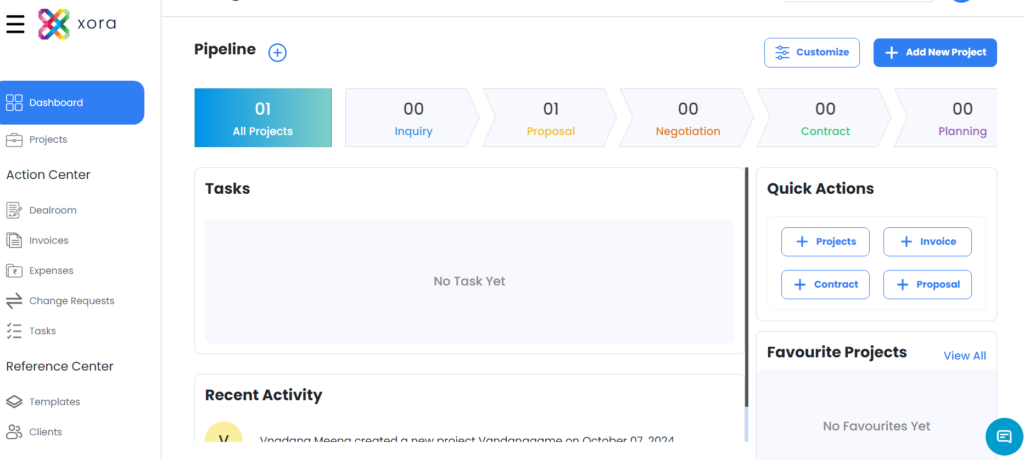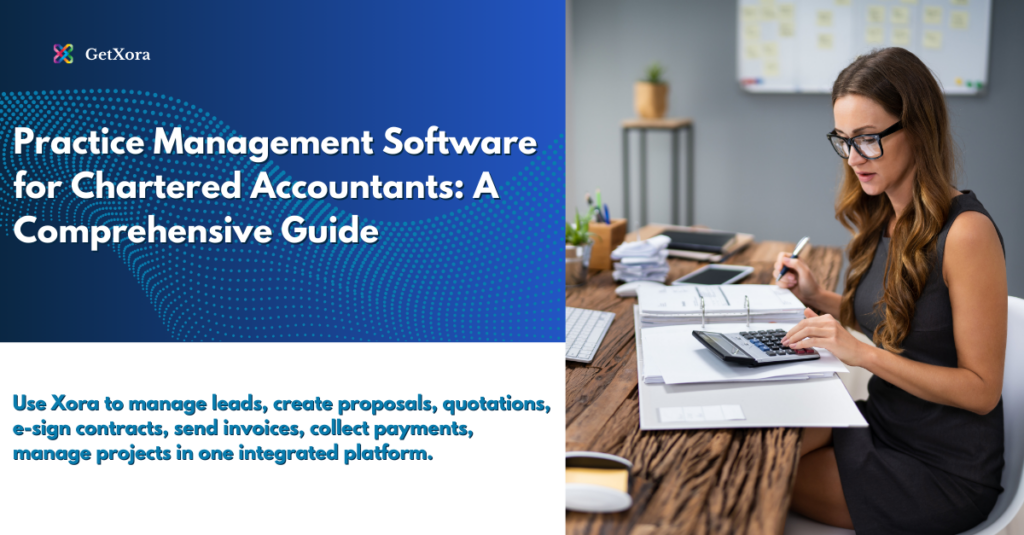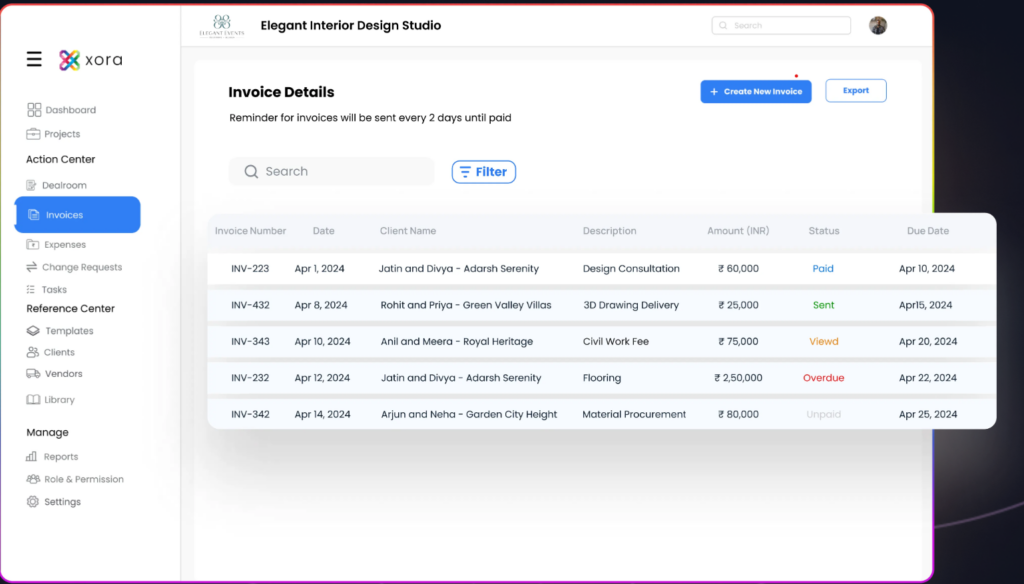Table of Contents
Introduction

In today’s fast-paced business environment, Chartered Accountants (CAs) are expected to wear many hats, from compliance specialists to strategic advisors. With the increasing complexity of financial regulations and the need for real-time insights, CAs must leverage technology to enhance their productivity and streamline their operations. CA office management software has emerged as an essential tool, enabling accountants to automate routine tasks, improve client communication, and ultimately boost productivity.
In this blog post, we will explore the significance of CA office management software, its key features, and six top tools that can help accountants optimize their practices. We will also discuss the benefits of implementing such software and provide guidance on selecting the right solution for your accounting firm.
The Importance of CA Office Management Software
CA office management software is crucial for modern accounting practices for several reasons:

- Streamlined Workflows: Automation reduces the time spent on repetitive tasks, allowing accountants to focus on higher-value activities. This transition from manual to automated processes is vital for maintaining efficiency in a busy accounting firm.
- Enhanced Collaboration: Many office management software solutions include features that facilitate collaboration among team members. For example, cloud-based solutions allow multiple users to access and edit documents simultaneously, making teamwork seamless.
- Improved Client Management: CA office management software often comes equipped with client relationship management (CRM) features that help accountants track client interactions, manage deadlines, and maintain comprehensive records, ultimately leading to better service delivery.
- Data Security: With sensitive financial information at stake, robust security measures are paramount. Most modern software solutions prioritize data security, ensuring client data is protected from unauthorized access and breaches.
- Informed Decision-Making: The reporting and analytics capabilities of CA office management software provide valuable insights into practice performance. This information allows accountants to make data-driven decisions that enhance operational efficiency.
Understanding CA Office Management Software
Before diving into specific tools, it’s essential to understand the primary functions of CA office management software:

- Task Management: Helps in assigning, tracking, and completing tasks efficiently.
- Document Management: Allows for secure storage and easy retrieval of financial documents.
- Time Tracking: Essential for billing clients accurately based on the time spent on their accounts.
- Client Portals: Provides clients with access to their financial information, invoices, and documents, enhancing transparency and engagement.
- Communication Tools: Facilitates better communication between accountants and clients, reducing misunderstandings and delays.
1. QuickBooks Online
QuickBooks Online is widely regarded as one of the best accounting software solutions for small to medium-sized businesses. It offers robust office management features that help streamline accounting tasks and boost productivity.
Key Features
- Automated Invoicing: Users can create and send professional invoices with just a few clicks. QuickBooks can also automate recurring invoices, saving time and reducing billing errors.
- Expense Tracking: QuickBooks allows for automatic importing of bank transactions, making it easy to categorize expenses accurately.
- Collaboration Tools: Accountants can share access with team members and clients, facilitating real-time collaboration on financial documents.
- Reports and Insights: Generate detailed financial reports that provide insights into a firm’s performance, aiding in strategic decision-making.
How It Boosts Productivity
By automating invoicing and expense tracking, QuickBooks Online allows accountants to save significant time on administrative tasks. The software’s reporting capabilities enable real-time insights, empowering accountants to advise clients based on up-to-date financial information.
2. Xero
Xero is another leading accounting software that offers a comprehensive suite of office management features tailored for Chartered Accountants. It enhances productivity by streamlining accounting processes.
Key Features
- User-Friendly Interface: Xero’s intuitive design allows for easy navigation, making it accessible for accountants at all skill levels.
- Real-Time Collaboration: Multiple users can access and edit financial data simultaneously, enhancing team collaboration.
- Customizable Dashboards: Users can create dashboards to monitor key financial metrics at a glance, facilitating quick access to important data.
- Integration with Other Tools: Xero integrates with a wide range of third-party applications, enhancing its functionality.
How It Boosts Productivity
With its user-friendly interface and real-time collaboration features, Xero minimizes the learning curve for new users, allowing them to become productive quickly. Accountants can access critical information and collaborate effectively, ensuring that deadlines are met.
3. Zoho Books
Zoho Books is an affordable yet powerful office management software solution ideal for small to medium-sized accounting firms. Its features cater to a variety of accounting needs.
Key Features
- Automated Workflows: Users can set up automated workflows for invoices, payments, and reminders, significantly reducing manual intervention.
- Client Portal: Zoho Books offers a secure portal for clients to view invoices and financial documents, enhancing engagement and transparency.
- Time Tracking: The software allows accountants to track billable hours accurately, ensuring proper client billing.
- Mobile Access: With its mobile app, accountants can manage tasks and access financial data on the go.
How It Boosts Productivity with Zoho Books
Zoho Books is designed with efficiency in mind, significantly boosting productivity for accountants and financial professionals. By automating repetitive tasks and enhancing client communication, Zoho Books allows accountants to focus on delivering high-quality services. Here’s how it achieves this:
- Automated Invoicing and Billing: Zoho Books simplifies the invoicing process by automating billing tasks. Users can set up recurring invoices, reducing the time spent on manual billing. This automation not only saves time but also minimizes the risk of errors associated with manual entries.
- Efficient Expense Tracking: The software automatically imports bank transactions and categorizes expenses, streamlining financial management. Accountants can quickly review and reconcile expenses without extensive manual work, allowing them to devote more time to analysis and strategic planning.
- Enhanced Client Communication: Zoho Books facilitates seamless communication with clients through built-in features such as email notifications and reminders. Accountants can send automated payment reminders and status updates, ensuring that clients are kept informed and engaged throughout the process.
- Comprehensive Reporting: The software’s robust reporting capabilities provide real-time insights into financial performance. Accountants can generate detailed reports with just a few clicks, helping them identify trends, monitor cash flow, and make informed business decisions. This accessibility to vital information enhances overall productivity.
- Mobile Access: The mobile access feature ensures that accountants can remain productive even when away from the office. Whether on-site with clients or traveling, they can manage invoices, track expenses, and access financial data on the go. This flexibility empowers professionals to stay connected and responsive to client needs, regardless of their location.
- Integration with Other Tools: Zoho Books integrates seamlessly with various third-party applications, such as CRM systems and project management tools. This integration allows for a unified workflow, where data can be shared across platforms, eliminating duplicate entries and further enhancing productivity.
By leveraging these features, accountants using Zoho Books can work more efficiently, improve client relationships, and focus on value-added services that drive business growth.
Practice Ignition
Practice Ignition is a unique software solution that combines client management and proposal creation, specifically designed for accounting firms. It streamlines the client onboarding process and offers several key benefits that can enhance productivity:
- Seamless Proposal Creation: With Practice Ignition, accountants can create professional proposals quickly and easily. The software provides customizable templates that allow firms to present their services and pricing clearly, helping to convert leads into clients more effectively.
- Client Onboarding Made Easy: The platform simplifies the onboarding process by enabling clients to accept proposals electronically. This reduces the time spent on paperwork and allows accountants to initiate projects faster, ensuring that clients feel welcomed and valued from the start.
- Automated Workflows: Practice Ignition automates various administrative tasks associated with client management, such as sending reminders for upcoming meetings, contract renewals, or payments. This automation minimizes the risk of oversight and ensures that important tasks are completed on time.
- Integration with Accounting Software: Practice Ignition integrates seamlessly with popular accounting software solutions like Xero and QuickBooks. This integration allows for automatic syncing of client data and financial information, streamlining workflows and reducing manual data entry.
- Client Management Dashboard: The software features a user-friendly dashboard that provides an overview of all client engagements. Accountants can easily track the status of proposals, monitor project timelines, and manage client interactions, enhancing overall organization and efficiency.
- Performance Tracking: Practice Ignition offers analytics tools that allow firms to monitor their performance over time. By tracking metrics such as conversion rates and client retention, firms can identify areas for improvement and make data-driven decisions to optimize their operations.
Key Features
- Proposal Templates: Create customized proposals for clients, detailing the services and pricing structures.
- Client Acceptance: Clients can accept proposals online, simplifying the onboarding process.
- Automated Billing: The software allows for setting up recurring billing and automating payment reminders, ensuring timely payments.
- Integration with Accounting Software: Practice Ignition integrates seamlessly with popular accounting tools, enhancing workflow efficiency.
How It Boosts Productivity
By simplifying the client onboarding process and automating billing, Practice Ignition allows accountants to focus more on delivering high-quality services rather than administrative tasks. Its integration capabilities further streamline operations.
5. Karbon
Karbon is designed specifically for accounting firms, providing a comprehensive platform for managing workflows, client communication, and collaboration.
Key Features
- Workflow Management: Users can create and manage workflows for various accounting tasks, ensuring that nothing falls through the cracks.
- Email Integration: Karbon allows users to manage client emails directly within the platform, reducing the need for multiple tools.
- Collaboration Tools: Accountants can share notes and documents with team members, facilitating effective collaboration.
- Client Management: Keep track of client interactions, deadlines, and documents all in one place.
How It Boosts Productivity
Karbon’s robust workflow management capabilities ensure that tasks are completed efficiently. By integrating email and collaboration tools, it minimizes the need for switching between different applications, enhancing productivity.
6. Microsoft Office 365
While not exclusively accounting software, Microsoft Office 365 offers essential tools that can significantly enhance productivity in accounting practices.
Key Features
- Excel for Financial Analysis: Utilize Excel’s powerful functions for complex financial modeling and analysis, making it an essential tool for accountants.
- Word for Documentation: Create professional documents, reports, and proposals with ease, ensuring high-quality client deliverables.
- Outlook for Communication: Manage client communications and schedules through Outlook, integrating email and calendar functionalities.
- Cloud Storage: Store documents securely on OneDrive for easy access and sharing.
How It Boosts Productivity
By leveraging the familiar tools in Microsoft Office 365, accountants can efficiently analyze data, create documents, and communicate effectively. The cloud storage feature ensures that documents are accessible from anywhere, facilitating remote collaboration.
Benefits of Implementing CA Office Management Software
Investing in the right CA office management software can yield numerous benefits for accounting firms. These advantages not only enhance operational efficiency but also improve client satisfaction and drive long-term success. Here’s a closer look at the key benefits:
1. Time Savings
One of the most significant benefits of implementing CA office management software is the time savings it provides:
- Automating Routine Tasks: By automating repetitive tasks such as invoicing, data entry, and report generation, accountants can significantly reduce the time spent on administrative work. This allows them to redirect their efforts toward higher-value activities, such as strategic planning and client advisory services.
- Streamlined Workflows: CA office management software often includes workflow automation features that help manage tasks and deadlines. With clear task assignments and reminders, accountants can focus on completing critical activities without the distraction of managing multiple to-do lists.
- Faster Client Onboarding: Automation speeds up the client onboarding process, reducing the time needed to set up new clients and projects. This efficiency not only saves time but also enhances the client experience from the very start.
2. Cost Efficiency
Implementing CA office management software can lead to cost efficiency for accounting firms:
- Reduced Overhead Costs: By streamlining operations and automating processes, firms can decrease the need for extensive administrative staff. This reduction in labor costs can contribute to a more profitable operation.
- Improved Resource Allocation: With enhanced efficiency, firms can better allocate their resources, ensuring that personnel are focused on billable work rather than administrative tasks. This maximizes the return on investment in human capital.
- Minimized Errors: Automation reduces the likelihood of human error in financial calculations and data entry, which can lead to costly mistakes. By minimizing these errors, firms can save money on corrections and potential penalties.
3. Enhanced Client Relationships
Implementing CA office management software leads to enhanced client relationships:
- Improved Communication: Many software solutions offer integrated communication tools, allowing for seamless interactions with clients. Whether through automated email updates or built-in messaging features, accountants can keep clients informed about their project status and respond promptly to inquiries.
- Faster Response Times: With streamlined processes and centralized information, accountants can respond to client requests more quickly. This responsiveness is critical in building trust and maintaining strong client relationships.
- Personalized Services: CA office management software allows firms to track client preferences and history easily. This information enables accountants to offer tailored services and recommendations, enhancing the overall client experience.
4. Scalability
Scalability is another key benefit of implementing CA office management software:
- Accommodating Growth: Many office management software solutions are designed to grow with your firm. As your client base expands or your service offerings increase, the software can adapt to accommodate additional workloads without requiring a complete overhaul.
- Flexible Features: Scalable software often includes customizable features that can be tailored to meet the evolving needs of the firm. This flexibility ensures that the software remains relevant as the business landscape changes.
- Support for New Clients: As your firm takes on new clients, office management software can streamline the onboarding process and ensure that your team is prepared to manage increased demand without sacrificing service quality.
5. Better Compliance
Implementing CA office management software can help firms achieve better compliance with regulatory requirements:
- Automated Compliance Tracking: Many software solutions include features that automatically track compliance deadlines and requirements. This proactive approach minimizes the risk of missing important dates and incurring penalties.
- Document Management: CA office management software often includes document management capabilities, ensuring that all client files and financial documents are stored securely and organized for easy access. This organization is essential for audits and compliance checks.
- Audit Trails: The software can maintain detailed records of all transactions and changes made, providing an audit trail that is invaluable for compliance purposes. This transparency can enhance the firm’s credibility and trustworthiness.
Conclusion
Choosing the Right CA Office Management Software
Selecting the right CA office management software for your firm is a critical decision that can significantly impact your operations and client relationships. The right software can streamline processes, enhance productivity, and ultimately lead to improved client satisfaction. Here are some key factors to consider when evaluating different options:
1. Firm Size
Understanding your firm’s size and structure is essential when choosing software. Different software solutions cater to varying business scales, so it’s important to select one that aligns with your needs.
- Solo Practitioners: If you are a sole practitioner, look for software that is user-friendly and cost-effective, offering essential features without unnecessary complexity. A simple interface can help you manage your workload effectively.
- Small to Medium Firms: For small to medium-sized firms, choose software that allows for multi-user access and collaboration features. This ensures that your team can work together seamlessly, sharing information and managing tasks efficiently.
- Large Firms: Large accounting firms often require more sophisticated solutions that can handle multiple users, departments, and extensive data. Look for robust software that offers advanced reporting, data management capabilities, and customizable workflows to accommodate your firm’s complexity.
2. Features
Assessing the features of the software is crucial to ensure it meets your specific needs. Different firms have different requirements based on their workflows and client services.
- Invoicing and Billing: Look for features that simplify the invoicing process, such as automated billing, customizable invoice templates, and integration with payment gateways for seamless transactions.
- Reporting and Analytics: The ability to generate reports is vital for understanding your firm’s performance. Seek software that offers customizable reporting options to track key performance indicators (KPIs) relevant to your practice.
- Client Management: A robust client management system allows you to maintain detailed client records, track interactions, and manage appointments effectively. This feature enhances communication and ensures that client needs are met promptly.
- Document Management: Consider software that includes document management capabilities. This feature allows you to store, organize, and retrieve important documents easily, streamlining workflows and enhancing collaboration.
3. Integration
Integration capabilities are essential for ensuring that the software works well with your existing tools and systems.
- Accounting Software: Choose software that integrates seamlessly with your accounting systems, allowing for smooth data transfer and minimizing manual data entry. This integration helps maintain accurate financial records and improves efficiency.
- CRM Systems: If your firm uses a CRM system, ensure that the office management software can integrate with it. This allows for better client tracking and improved communication, as client information can be accessed from both systems.
- Other Tools: Consider other tools your firm currently uses, such as email marketing platforms or project management software. The ability to integrate with these tools can enhance productivity and streamline your operations.
4. User Experience
User experience (UX) is a critical factor that can influence how effectively your team uses the software.
- User Interface: Evaluate the software’s user interface for ease of navigation. A clean and intuitive design can reduce the learning curve for your team and encourage adoption.
- Accessibility: Check if the software is accessible on various devices, including desktops, tablets, and smartphones. Mobile accessibility can be a significant advantage for teams that are often on the move.
- Customization Options: Look for software that allows for customization of dashboards and workflows. This flexibility can enhance usability and ensure that the software aligns with your team’s specific workflows.
5. Cost
Evaluating the pricing structure of the software is crucial to ensure that it fits within your budget while providing the necessary features.
- Subscription Models: Most software today operates on subscription-based pricing. Compare different pricing tiers to find one that offers the best value for your firm. Ensure you understand what features are included at each level.
- Additional Costs: Be mindful of any additional costs that may arise, such as fees for additional users, integrations, or advanced features. Clarifying these costs upfront can prevent unexpected expenses later on.
- Trial Periods: Look for software that offers a trial period. This allows you to test the software’s features and usability before committing to a long-term subscription. Take advantage of the trial to gather feedback from your team about their experience.
Conclusion
Investing in the right CA office management software is crucial for improving operational efficiency and client satisfaction. The tools discussed in this blog—QuickBooks Online, Xero, Zoho Books, Practice Ignition, Karbon, and Microsoft Office 365—each offer unique features tailored to the needs of Chartered Accountants. By streamlining workflows, automating routine tasks, and improving client communication, these software solutions empower accountants to focus on providing strategic insights and value to their clients.
Are you ready to boost productivity in your accounting practice? Explore these CA office management software options and discover the best fit for your firm. Visit GetXora.com for more innovative solutions

Leave a Reply